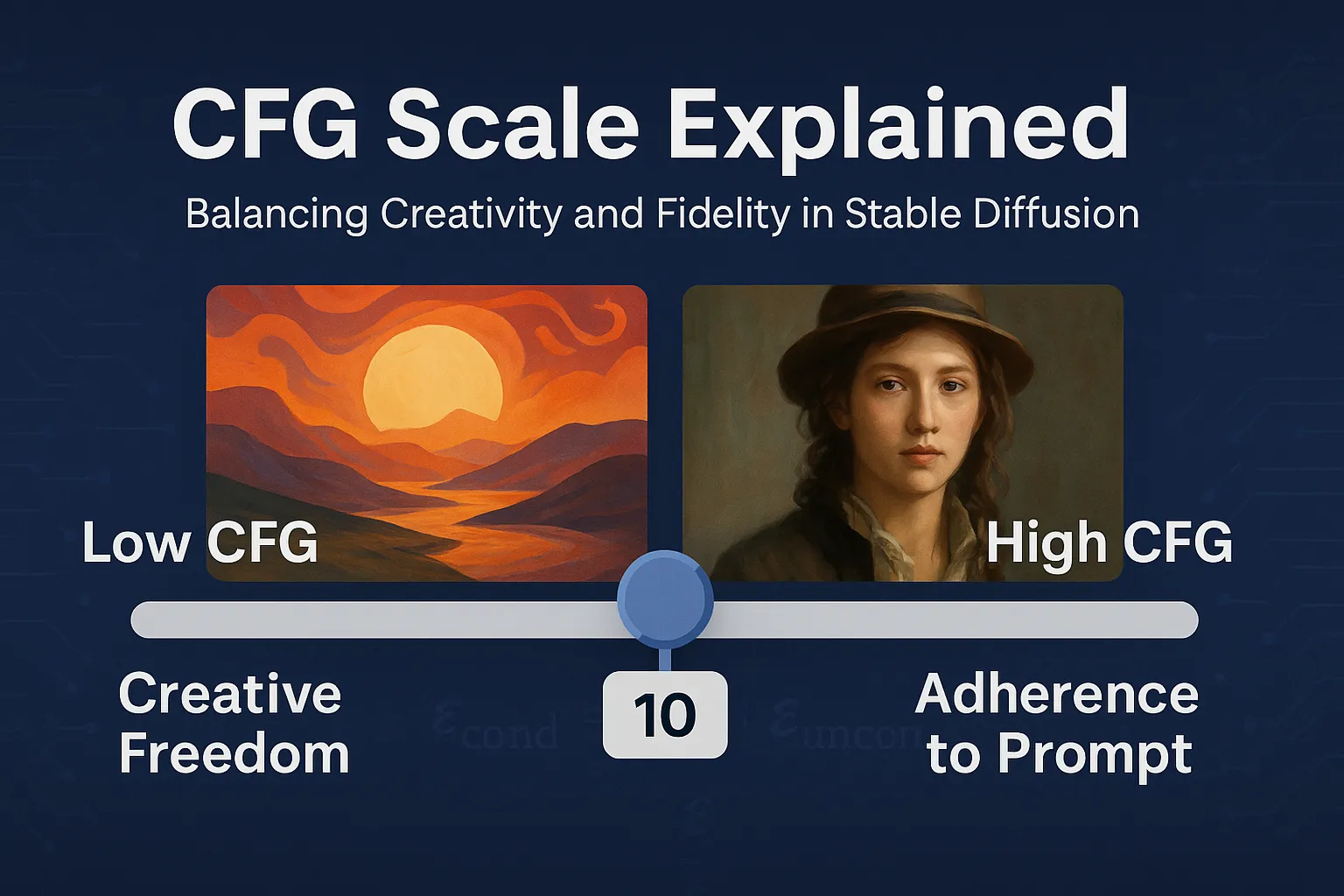CFG Scale Explained: 2025 Ultimate Guide & Free Tool
CFG Scale Explained: Balancing Creativity and Fidelity in Stable Diffusion
CFG Scale (Classifier-Free Guidance Scale) is an important hyperparameter in diffusion-based image generation models such as Stable Diffusion. It controls the model’s creative freedom and how closely it adheres to your text prompt. At low CFG values, the model explores more divergent, creative results; at high CFG values, it stays close to the prompt but can result in repetitive or oversaturated results. Understanding and tweaking CFG Scale puts you in control to dial in to just the right degree—whether you are aiming for dreamy artistic license or precise visual duplication.
Table of Contents
- What Is CFG Scale?
- How CFG Scale Works: Math & Intuition
- Why CFG Scale Matters: Creativity vs. Fidelity
- Optimal Ranges & Best Practices
- Interactive Example & Code Snippet
- Latest Advances: CFG-Zero* & DICE
- Frequently Asked Questions
- Conclusion
What Is CFG Scale?
CFG Scale, which stands for Classifier-Free Guidance Scale, is a scalar multiplier of the difference between the conditional (prompt-conditioned) and unconditional (null-prompt) denoising steps in diffusion models. Practically, you calculate two noise-predictions—one conditioned on your text prompt, one unconditioned—and then interpolate between them based on the CFG value. Interpolation forces the model to adhere to the prompt more strongly as CFG is scaled up.
How CFG Scale Works: Math & Intuition
Under the hood, diffusion models predict noise at each denoising step. Let:
εcond = noise predicted with prompt conditioning
εuncond = noise predicted without conditioning
The guided noise εguided = εuncond + s · (εcond − εuncond), where s is your CFG Scale. When s = 1, the model follows the conditional path by default; increasing s amplifies the prompt influence.
Intuition: Envision εuncond as the model’s free-form creativity and εcond as your prompt’s “gravitational pull.” CFG Scale adjusts how strongly the pull overrides the free-form drive.
Why CFG Scale Matters: Creativity vs. Fidelity
CFG Scale directly affects two valuable dimensions:
1. Creative Divergence
Smaller scales enable the latent sampler to explore unexpected modes—ideal for abstract art, surreal scenery, or prompt exploration.
2. Prompt Consistency
Larger scales enforce strict adherence—a necessity for product design, character design, or any application where accuracy is key.
By mastering CFG tuning, you avoid problems like “prompt overfitting” (images look noisy or repetitive) or “underfitting” (outputs ignore valuable prompt details).
Optimal Ranges & Best Practices
| Use-Case | CFG Range | Tips |
|---|---|---|
| Abstract Art | 3–6 | Embrace lower values for serendipity |
| Character Illustrations | 7–11 | Balance fidelity and stylization |
| Product Mockups & Branding | 12–20 | Lean high for precise feature rendering |
| Batch Generation | 9–13 | Keeps consistency across multiple samples |
General Guidelines:
– Start at 7 or 8 for most use cases.
– Make small sweeps (e.g., 5, 7, 9, 11) and compare.
– If outputs look washed out or too “text-heavy,” reduce the scale.
– If details are skipped or prompts are ignored, try increasing the scale.
Interactive Example & Code Snippet
from diffusers import StableDiffusionPipeline
import torch
pipe = StableDiffusionPipeline.from_pretrained(“runwayml/stable-diffusion-v1-5”, torch_dtype=torch.float16)
pipe.to(“cuda”)
prompt = “A futuristic city skyline at sunset”
images = pipe(prompt, guidance_scale=9.5, num_inference_steps=50).images
images[0].save(“output.png”)
guidance_scale=9.5: strikes a balance for most scenic prompts.
Adjust guidance_scale up or down in increments of 1.0 to see its impact in real time.
Latest Advances: CFG-Zero* & DICE
- CFG-Zero*
A new guidance algorithm that adaptively scales per denoising step to avert overfitting in later stages, leading to sharper details without sacrificing diversity. - DICE (Dynamic Image Conditioning Engine)
Includes a dynamic weighting schedule rather than a fixed scalar—early steps use low guidance, later steps scale up for precision, with up to 20% gain in prompt-faithful rendering.
Keep an eye on new arXiv releases—incorporating these can push your CFG outputs even further ahead of the curve.
Frequently Asked Questions
Can I use fractional CFG scales (e.g. 7.3)?
Yes. Fractional values offer greater control; however, variations less than 0.5 yield subtle variations.
Does a higher CFG always work better?
Not necessarily. Beyond a certain point (≈18–20), outputs can become noisy or overly literal. Always balance fidelity needs and creativity.
How does CFG interact with other parameters (e.g. steps, sampler)?
More steps can amplify CFG effects—try 50+ steps when fine-tuning. Other samplers (Euler, LMS) may necessitate CFG adjustments of ±1–2.
Conclusion
CFG Scale is your single most powerful lever for steering Stable Diffusion outputs between artistic freedom and strict prompt adherence. By starting with a medium range (7–12), running targeted sweeps, and experimenting with advanced methods like CFG-Zero* and DICE, you’ll master the balance every time—whether you’re creating abstract landscapes or pixel-perfect product renders.




